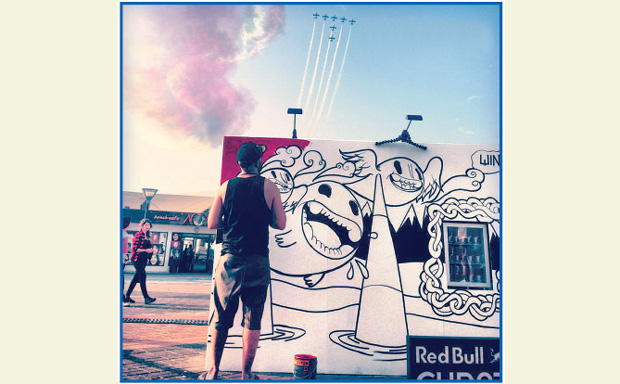From a new urban lifestyle centre built out of hundreds of brightly coloured shipping containers, to art galleries in architect-designed warehouses and new smart hubs that nurture global design talent, this is the kind of young, urban scene you find in Lon-don’s Shoreditch, Miami’s Wynwood district or the hippest areas of Brooklyn.
But this is Dubai. This is the city whose strategically-located port, oil wealth and prominence as a global financial centre have long made it a magnet for those seeking to make their fortune.
Now, Dubai is maturing. It no longer wants to be seen as a transient place where everything built during a construction boom in the early 2000s was the world’s first, biggest or best.
Following the global financial and real estate downturn in 2008, many questioned whether this gleaming, young city had the resilience to bounce back. The answer is undeniably yes — but this time, with new strings to its bow.
It’s a fitting metaphor as music — and the arts in a broader sense — are some of the ways in which Dubai is carving out a new identity as a place of cultural innovation. Its aim now is to cement a reputation as the leading creative hub of the Middle East. In turn, Dubai hopes that it will become a place where individuals and families from all over the world will want to put down roots for the long term.
No ordinary opera
Dubai Opera, the focal point of the city’s new Opera District, is now open, bringing a new major performance space to the city. Shaped like a wooden dhow, the gleaming opera house designed by the architect Janus Rostock is both a tribute to Dubai’s maritime history and a modern, flexible arts centre — one that can be transformed from a 2,000-seat theatre to a concert hall that wraps its orchestra in an acoustic shell. Its floor can also be flattened to become an event space for anything from banquets to trade shows. The surrounding Opera District provides new parks and waterfront walkways, retail and high-end residential apartments, including Emaar’s 66-storey Opera Grand, close to the Burj Khalifa.
In recent years, Dubai has excelled in attracting young international talent, but mainly in finance and business. It is now seeking to diversify by offering the kind of culture, work hubs and social spaces that see a new generation of creative pioneers considering working and living in Dubai as they might do in London, Berlin or New York.
The design industry in the Middle East is worth around $2.3 billion (Dh8.44 billion), and Dubai is perfectly placed to harness the best of the East and West. Its emerging artists and fashion designers, along with major global brands, have a new home in Dubai Design District (d3), with high-tech and world-class offices, studios and ateliers. These are creative spaces that blur the distinction between work and play — a workspace whose atmosphere (and appealing places to eat and drink) encourages its community to socialise after hours. A residential element is also planned for the next phase of d3.
While Dubai is well-known for its leading commercial and residential architectural designs, it is now evolving to encourage more independent, artistic direction. With the emirate home to 200 nationalities, it already has a vibrant, diverse community to provide the building blocks. An ever-growing calendar of annual design-themed events is also helping to foster this community. Springtime in Dubai heralds the start, with Art Dubai and the Sikka Art Fair in March, World Art Dubai and Fashion Forward in April and towards the end of the year, Dubai Design Week, which attracted 23,000 visitors and 150 designers in its 2015 debut.
Alserkal Avenue, a new arts hub that began to take shape in Dubai’s industrial quarter in 2007, appeals to a similar creative audience, with its warehouses now home to artists’ studios, galleries and educational spaces for community-led cultural initiatives and independent theatre and cinema.
Dubai’s new direction isn’t all about art but there is a new awareness of urban design pervading its commerce. Box Park brings a new “urban lifestyle concept”, according to its maker, Meraas, which has turned 220 shipping containers into a new shopping district that includes new, cutting-edge brands such as Urbanist, OnePiece and new women’s cycling brand Liv.
Hotels are also getting in on the act. Rove Downtown Dubai is unlike any other hotel in the city. It’s marketed as a “design-influenced, value-lifestyle” hotel and it pro vides the high-tech social hub that young travellers want.
Sporting culture
Dubai has more than 400 gyms and sees over $1.7 billion a year on sport-related expenditure. There is little you can’t do sports-wise in Dubai — and that includes skiing. But the city’s leisure scene is taking on a new hue with the proliferation of mass-participation street races such as We Run Dubai, the Electric Run and Colour Run, as well as the Dubai Marathon, which saw 25,000 runners last year and sits alongside such staples of Dubai’s sporting calendar as the Dubai Tour and Dubai World Cup.
Through its development of art, design, music and sport, Dubai is learning that urbanism is about far more than building the world’s biggest towers. It’s also about building diverse communities of people that live in, around and within sight of them — and about giving them plenty of reasons to stay.
All rights reserved to the initial publisher for gnproperty.com
Collected and published by Arms &McGregor International Realty® editorial team. Get in touched with us at [email protected]

